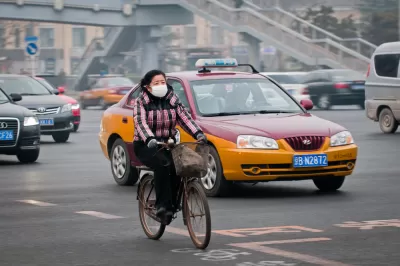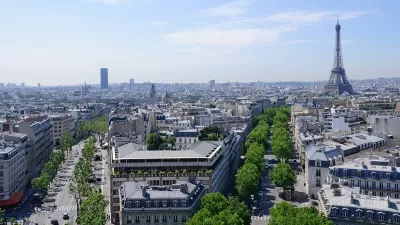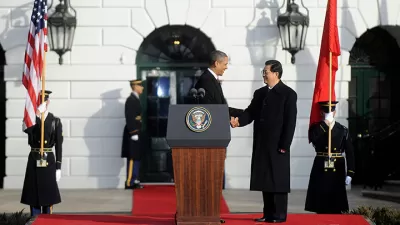The Call to Action on Climate and Health is an ambitious plan to achieve both global climate and health goals. Planners can help identify win-win solutions that provide multiple benefits and so can build broad implementation coalitions.

Conventional planning tends to be reductionist—individual problems are assigned to organizations or professions with narrowly-defined responsibilities. For example, transportation agencies are responsible for reducing traffic congestion and accidents; public health agencies are responsible for increasing public fitness and health; environmental agencies are responsible for reducing pollution; and social service agencies are responsible for improving opportunities for disadvantaged groups. This simplifies the planning process but can result in these organizations rationally implementing solutions to the problems within their scope that exacerbate other problems facing society. It also tends to undervalue solutions that provide dispersed benefits.
More comprehensive analysis considers multiple planning goals, and so it helps to identify win-win strategies, which are policy and programs that provide multiple benefits, such as congestion reduction strategies that also help improve public fitness, reduce pollution, and improve mobility options for non-drivers. These are often referred to co-benefits. Because they help achieve multiple goals they create opportunities for multi-stakeholder coalitions, for example, a partnership between transportation, environmental, health, and social service agencies to support policies that create more compact and multimodal communities.
Win-win solutions can help solve our most intractable problems. Last week I spoke at the Global Climate and Health Forum in San Francisco, part of the Global Climate Action Summit. This was an amazing event that included presentations by world health and environmental leaders. My presentation discussed win-win strategies that reduce climate emissions and help achieve other health objectives, including reduced local pollution, increased physical activity and fitness, reduced traffic accidents, increase affordability and improve mobility for non-drivers. I was pleased to see that the Forum's Call to Action recommendations includes many of these ideas, such as more planning for active transportation.
In contrast, the new book, Drawdown, uses reductionist analysis to evaluate potential climate emission reduction strategies. As a result, it favors technological solutions that provide limited benefits: few of the solutions highlighted in the book help reduce traffic congestion or accidents, improve public health, increase affordability, or improve mobility options for non-drivers, as illustrated in the following table.
Drawdown’s Eleven Top Transportation Emission Reduction Strategies
Strategies |
GHG Reductions |
Pollution Exposure |
Physical Activity |
Traffic Safety |
Affordability |
Airplanes – increased use of technologies to reduce aircraft fuel burn |
X |
||||
Cars – increased use of hybrid cars |
X |
X |
|||
Electric Bikes – increased use of electric bikes instead of cars for urban travel |
X |
X |
X |
||
Electric Vehicles – increased use of battery and plug-in hybrid vehicles |
X |
X |
|||
High-Speed Rail – track construction for increased use of high-speed rail for intercity travel |
X |
X |
|||
Mass Transit – increased usage of mass transit or public transport to get around cities |
X |
X |
X |
X |
X |
Ridesharing – increased ride-sharing when commuting in North America |
X |
X |
X |
||
Ships – the use of technologies to make maritime shipping less fuel-intensive |
X |
X |
|||
Telepresence – replacing flying for business meetings with telepresence technologies |
X |
X |
|||
Trains – increased electrification of freight railways |
X |
X |
|||
Trucks – increased use of fuel reduction technologies and approaches for trucking |
X |
X |
Although all Drawdown strategies reduce climate emissions and most reduce people’s exposure to local pollution, few help achieve other health goals, such as increasing physical activity, reducing crash risk, or improving affordability.
In its Buildings and Cities section, Drawdown does propose active transportation improvements:
Walkable Cities – designing and retrofitting urban environments to encourage walking for commute or transportation, thereby reducing transportation via internal combustion engine powered vehicles and their associated emissions.
Bike Infrastructure – modifying or augmenting urban right of ways to have specific infrastructure reserved for bicycle commuting and segregated physically or by marking from car and pedestrian right of ways.
Those are good ideas, but they fail to convey the integrated policy changes needed to make truly walkable and bikable communities. Walking and bicycling need much more than specialized infrastructure. To significantly increase use of these modes and reduce automobile travel, we need more compact and mixed development, so destinations are closer together; more connected and narrower roadways; lower traffic speeds; better public transit services; and reduced parking subsidies. If implemented together these Smart Growth policies can provide large emission reductions.
There are other reasons for planners to criticize Drawdown's approach. It simply describes technologies with no plan that identifies exactly how these technologies should be implemented for maximum benefit, such as carbon and fuel taxes to make fossil fuels more costly to use, transport planning reforms that favor resource-efficient modes over private automobile travel, and Smart Growth development policies to create more compact and multimodal communities. Without a well-thought-out implementation plan, a list of desirable technologies is virtually worthless or even harmful. For example, because many of the technologies they recommend are expensive, policies that favor them (for example, subsidies for hybrid and electric vehicles, or allowing them to operate in high-occupancy vehicle lanes) are regressive and can harm lower-income people, and because they are cheaper to operate than gasoline vehicles, they tend to increase total vehicle travel and sprawl. I contacted the Drawdown team several weeks ago to offer assistance in identifying emission reduction implementation strategies, but they never replied. Policy implementation is apparently outside Drawdown's scope of analysis.
Drawdown also makes optimistic claims about the potential emission reduction benefits of educating girls, based on the assumption that this reduces birth rates and therefore future energy consumption. However, education also tends to increase economic aspirations, employment opportunities, incomes and therefore consumption rates, factors that do not seem to have been considered in their analysis. I strongly support increasing education in developing countries, but am skeptical that by itself it can be considered a major energy conservation and emission reduction strategy.
Achieving ambitious planning goals requires more than just new technologies—it requires a paradigm shift from reductionist to comprehensive planning. When all impacts are considered, win-win strategies often turn out to be most cost effective and beneficial solutions overall, and they provide opportunities to build coalitions among diverse groups to implement innovative solutions. This theme came up frequently in the Forum: many citizens are more concerned about health and safety, affordability and opportunity than climate change; rather than trying to convince them to change their priorities, it is better to find solutions that help achieve everybody's goals.
For More Information
Paul G. Bain, et al. (2016), "Co-benefits of Addressing Climate Change Can Motivate Action Around the World,"Nature Climate Change, Vol. 6(2), pp. 154-157.
Cambridge Systematics (2009), Moving Cooler: Transportation Strategies to Reduce Greenhouse Gas Emissions, Urban Land Institute and various cosponsers.
Climate Works (2014), Climate-Smart Development: Adding Up the Benefits of Actions that Help Build Prosperity, End Poverty and Combat Climate Change, Climate Works Foundation (www.climateworks.org) and World Bank (www.worldbank.org).
Allen Greenberg and Jay Evans (2017), Comparing Greenhouse Gas Reductions and Legal Implementation Possibilities for Pay-to-Save Transportation Price-shifting Strategies and EPA’s Clean Power Plan, Victoria Transport Policy Institute.
IGES (2015), Transport Co-benefits Calculator, Development Impact Assessment Toolkit, Institute for Global Environmental Strategies.
John D. Landis, David Hsu, Erick Guerra (2017), “Intersecting Residential and Transportation CO2 Emissions: Metropolitan Climate Change Programs in the Age of Trump,” Journal of Planning Education and Research, (DOI: 10.1177/0739456X17729438).
Laura Merrill, et al. (2015), Tackling Fossil Fuel Subsidies and Climate Change: Levelling the Energy Playing Field, Nordic Council of Ministers.
PPMC (2016), An Actionable Vision of Transport Decarbonization: Implementing the Paris Agreement in a Global Roadmap Aiming At Net-Zero Emissions Transport, Paris Process On Mobility And Climate (PPMC) On Behalf of the Global Climate Action Agenda Transport Team.
Caroline J. Rodier, et al. (2014), Active Travel Co-Benefits Of Travel Demand Management Policies That Reduce Greenhouse Gas Emissions, report 12-12, Mineta Transportation Institute.
USCoM and C2ES (2018), Mayors Leading the Way on Climate How Cities Large and Small are Taking Action, Alliance for a Sustainable Future, A joint effort by The U.S. Conference of Mayors and the Center for Climate and Energy Solutions.

Trump Administration Could Effectively End Housing Voucher Program
Federal officials are eyeing major cuts to the Section 8 program that helps millions of low-income households pay rent.

Planetizen Federal Action Tracker
A weekly monitor of how Trump’s orders and actions are impacting planners and planning in America.

Ken Jennings Launches Transit Web Series
The Jeopardy champ wants you to ride public transit.

California Invests Additional $5M in Electric School Buses
The state wants to electrify all of its school bus fleets by 2035.

Austin Launches $2M Homelessness Prevention Fund
A new grant program from the city’s Homeless Strategy Office will fund rental assistance and supportive services.

Alabama School Forestry Initiative Brings Trees to Schoolyards
Trees can improve physical and mental health for students and commnity members.
Urban Design for Planners 1: Software Tools
This six-course series explores essential urban design concepts using open source software and equips planners with the tools they need to participate fully in the urban design process.
Planning for Universal Design
Learn the tools for implementing Universal Design in planning regulations.
Ada County Highway District
Clanton & Associates, Inc.
Jessamine County Fiscal Court
Institute for Housing and Urban Development Studies (IHS)
City of Grandview
Harvard GSD Executive Education
Toledo-Lucas County Plan Commissions
Salt Lake City
NYU Wagner Graduate School of Public Service





























